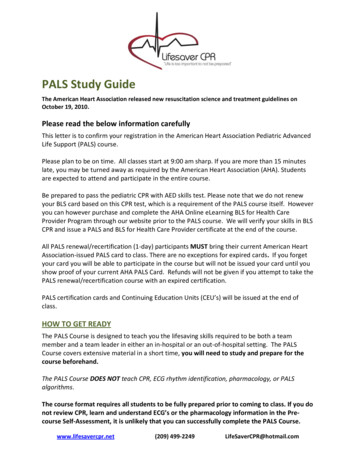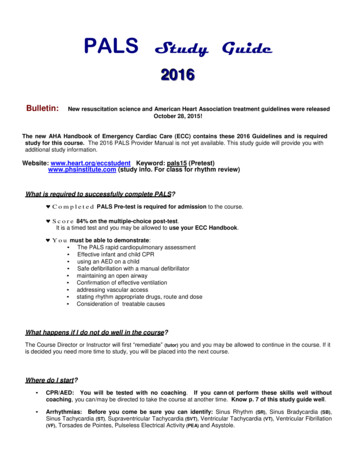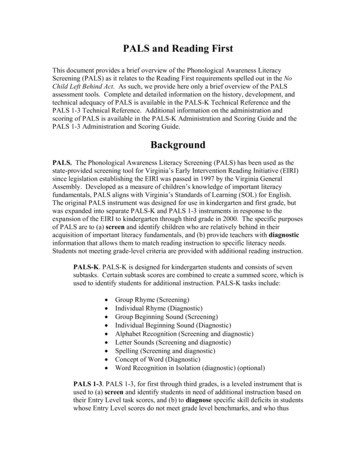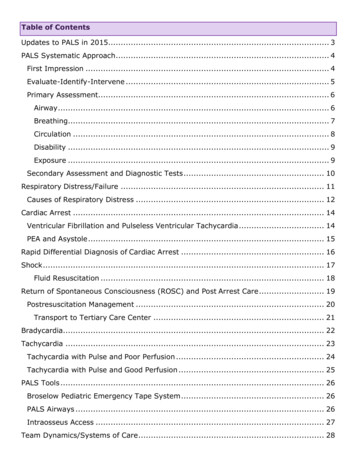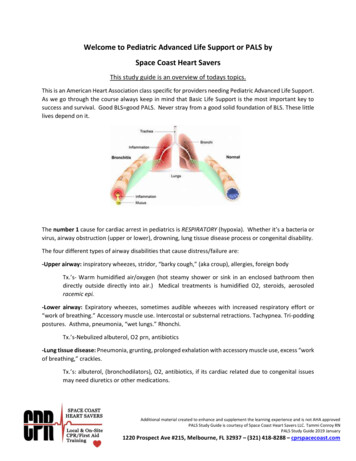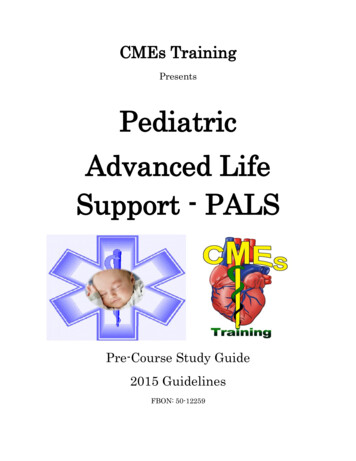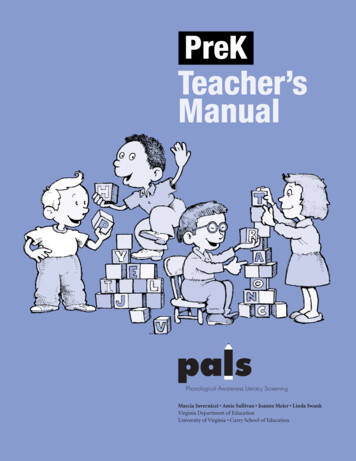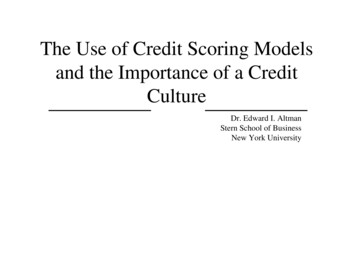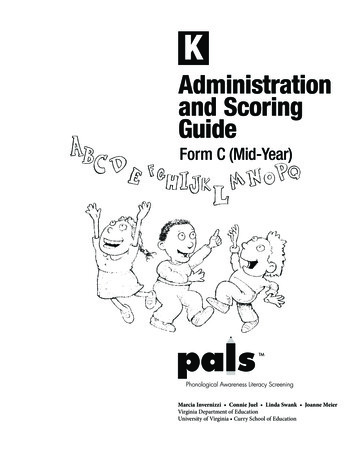
Transcription
KAdministrationand ScoringGuideForm C (Mid-Year)Marcia Invernizzi Connie Juel Linda Swank Joanne MeierVirginia Department of EducationUniversity of Virginia Curry School of Education
All rights reserved. The Virginia Department of Education and Virginia schools participating in theVirginia Early Intervention Reading Initiative are licensed to duplicate this assessment package for thecontractual period. No part of these materials protected by this copyright notice may be reproduced orutilized in any form or by any means by persons or school divisions not participating in the Virginia EarlyIntervention Reading Initiative without prior written permission of the copyright owner. Reproductionand/or utilization includes electronic or mechanical, including photocopying, recording, or by anyinformation storage and retrieval system. 2003–2017 by The Rector and The Board of Visitors of the University of Virginia. All Rights Reserved.Design: Branner Graphic DesignLine Drawings: Casey Rexrode, Francine JohnstonCover Illustration: Charles PealePrinted in the United States of America
KAdministration and Scoring GuideMarcia Invernizzi Connie Juel Linda Swank Joanne MeierVirginia Department of EducationUniversity of Virginia Curry School of EducationAcknowledgementsDevelopment of the Phonological Awareness Literacy Screening for Kindergarten(PALS-K) has been supported by the Virginia Department of Education throughVirginia’s Early Intervention Reading Initiative. Without the support provided bythe Virginia Department of Education, test development required for this assessment would not have been possible.The PALS Office would like to thank several generations of graduate studentsfrom the McGuffey Reading Center who have contributed directly to thedevelopment of these tasks, as well as current and former Project Managers:Jenni Ballow, Allison Drake, Jenny Howell, Ellen Shrum, Amie Sullivan, andHeather Warley.
Table of Contents444455561010141822PALS-KTime Required for ScreeningAdministration ManagementBasic Screening ProceduresTasksOptions for AdministrationStudent Summary SheetClass Summary Sheet24Section II: Alphabet KnowledgeSection I: Phonological AwarenessPart A: Group Rhyme AwarenessPart B: Group Beginning Sound AwarenessPart C: Individual Rhyme AwarenessPart D: Individual Beginning Sound Awareness24Lower-Case Alphabet Recognition252526Section III: Letter-Sound KnowledgePart A: Letter SoundsPart B: Spelling29Section IV: Concept of Word31Section V: Word Recognition in Isolation32Entering PALS-K Scores on the Website3333Traditional Score EntryOnline Assessment Wizard34Interpreting Mid-Year PALS ResultsAdministration and Scoring Guide 2003–2017 by The Rector and The Board of Visitors of the University of Virginia. All Rights Reserved.
PALS-KTime Required forScreeningTeachers should complete the PALS-K screening within any contiguous twoweek period within the four-week screening window. There are no time l imits onthe individual tasks on PALS-K; therefore, the amount of time required toadminister the screening can vary. Some children may perform better if theteacher divides PALS-K into several screening sessions. For example, each taskcould be administered on a different day. Based upon a teacher’s experience withthe students in his or her class, he or she could set aside appropriate amounts oftime over the course of two weeks for screening. It is important to ensure thateach student is screened under optimal conditions.AdministrationManagementThe mid-year screening window is optional. It is not required that an entireschool participate or that a teacher screen every student in the class. Therefore,a teacher can screen the entire class or some of the students in the class. Ateacher can participate even if other teachers in the school are not participatingin mid-year.We recommend that classroom teachers administer the screening to each student.Classroom teachers know their children better than anyone in the building, andbecause of this, may obtain the most accurate screening results from the children.Many schools have devised ways to accommodate classroom coverage for classroom teachers by temporarily readjusting the schedule of the reading specialistor classroom assistants.The majority of the PALS-K screening is administered individually. However, theGroup Rhyme Awareness, Group Beginning Sound Awareness, and Spellingtasks may be given in small groups of five or fewer students.Basic ScreeningProceduresExact screening items should not be pre-taught nor should a copy of PALS besent home to be practiced ahead of time. Pre-teaching the exact items on anassessment invalidates the results, interferes with accurate progress monitoring,and could even prevent a student from getting the additional instruction theyneed. While it is important to teach the same skills assessed by PALS, responsible test users do not teach these skills using test materials. Every teacher who willbe involved in the screening should follow the procedures outlined below:Before Screening1. Read the Form C (Mid-Year) PALS-K Administration and Scoring Guide.2. Establish an environment that is relatively free of distractions, well lighted,and comfortable.3. Ensure that all the materials required to complete each task are available andready to use.During Each Screening Task1. Introduce each task immediately before asking the student to complete it.2. Monitor each student carefully, offering encouragement and praise.3. Score all items as directed in this Administration and Scoring Guide.Administration and Scoring Guide 2003–2017 by The Rector and The Board of Visitors of the University of Virginia. All Rights Reserved.4
After Screening1. Record students’ scores on the Class Summary Sheet.2. Go to the PALS Web site and log into your PALS account (explained in moredetail on page 32).TasksWordRecognitionin IsolationConcept ofWordTaskMaximumGroup Rhyme10Group Beginning Sounds10Individual Rhyme10Individual Beginning Sounds10Lower-case Alphabet Recognition26Letter Sounds26Spelling20Pointing4Word ID8COW Word List10Preprimer List20Primer List20First Grade List20NOTE: While mid-year tasks are optional, the best way to obtain an accuratepicture of students’ growth is to administer the tasks that you administered in thefall. If a student achieved a perfect score on a task in the fall, it is not necessary toreadminister the task.Options forAdministrationStudent SummarySheetTaskIndividualSmall GroupGroup Rhyme Group Beginning Sounds Individual Rhyme Individual Beginning Sounds Lower-case Alphabet Recognition Letter Sounds Spelling Concept of Word Word Recognition in Isolation The Student Summary Sheet is used to record PALS-K scores for one student.Space is provided on the Student Summary Sheet to record a student’s scores oneach task. An example of a Student Summary Sheet may be found on pages 7and 8.Administration and Scoring Guide 2003–2017 by The Rector and The Board of Visitors of the University of Virginia. All Rights Reserved.5
Class SummarySheetThe Class Summary Sheet is used to record scores and pertinent information foran entire class, however some teachers prefer to enter the information into theOnline System directly from the Student Summary Sheet. Along with name,birth date, and gender, the following information is recorded for each student ontheir student information page within your website account.Ethnicity*Is this student identified as Latino/Hispanic?00 No01 YesRace*Single Race01 American Indian orAlaska Native02 Asian03 Black or AfricanAmerican04 Unspecified05 White06 Native Hawaiian orOther Pacific IslanderCombination of Two Races07 American Indian or Alaska 08 American Indian or AlaskaNative and AsianNative and Black or AfricanAmerican12 Asian and White13 Asian and Native Hawaiianor Other Pacific Islander09 American Indian or Alaska 10 American Indian or AlaskaNative and WhiteNative and Native Hawaiian orOther Pacific Islander14 Black or African American 15 Black or African Americanand Whiteand Native Hawaiian or OtherPacific Islander11 Asian and Black or AfricanAmerican16 Native Hawaiian or OtherPacific Islander and WhiteCombination of Three Races17 American Indian or Alaska 18 American Indian or Alaska 19 American Indian or AlaskaNative and Asian and NativeNative and Asian and Black or Native and Asian and WhiteHawaiian or Other PacificAfrican AmericanIslander22 Black or African American 23 American Indian or Alaska 24 American Indian or AlaskaNative and Black or AfricanNative and Black or Africanand Native Hawaiian or OtherAmerican and Native Hawaiian American and WhitePacific Islander and Whiteor Other Pacific Islander20 Asian and Black or African 21 Asian and Black or AfricanAmerican and WhiteAmerican and Native Hawaiianor Other Pacific Islander25 American Indian or Alaska 26 Asian and Native HawaiianNative and Native Hawaiian or or Other Pacific Islander andOther Pacific Islander and White WhiteCombination of Four Races27 American Indian or Alaska 28 Asian and Black or AfricanNative and Asian and Black or American and Native HawaiianAfrican American and Whiteor Other Pacific Islander andWhite29 American Indian or AlaskaNative and Black or AfricanAmerican and Native Hawaiianor Other Pacific Islander andWhite30 American Indian or AlaskaNative and Asian and NativeHawaiian or Other PacificIslander and White31 American Indian or AlaskaNative and Asian and Black orAfrican American and NativeHawaiian or Other PacificIslanderDisability Categories (select the primary disability)01 None04 Multiple Disabilities05 Orthopedic Impairment06 Visual Impairment (includes Blindness)07 Hearing Impairment (includes Deafness)08 Specific Learning Disability09 Emotional Disturbance (includes Emotional Disability)10 Speech or Language Impairment11 Other Health Impairment12 Deaf-Blindness13 Autism14 Traumatic Brain Injury15 Otherwise Qualified Handicapped under Sec. 50416 Developmental Delay (through age 8)19 Intellectual DisabilityServices00 None01 PALS Intervention02 Title I (Reading)03 ESL (service provided to some LEP students)04 Tutor (one-on-one tutorial programs such as Book 05 Other (specify)Buddies, Reading Recovery, Howard Street, etc.)OtherIs this student a native English speaker?00 No01 YesDoes this student receive dual-language instruction (e.g., language immersion, bilingual)?00 No01 Yes*The Race and Ethnicity categories are from the U.S. Department of Education.Administration and Scoring Guide 2003–2017 by The Rector and The Board of Visitors of the University of Virginia. All Rights Reserved.6
Sample: Mid-Year Student Summary SheetK Form C (Mid-Year)20 Student Summary SheetPhonological Awareness Literacy ScreeningStudent (first & last):Teacher:Assessment Date: Section I Section IPart A: Group Rhyme AwarenessPart C: Individual Rhyme Awareness1. shelltireropebell /1. rocktreesock2. ringtwoswingbox2. hatdogshoebat3. pietiedogshoe3. snailwhaleropetent4. snailbiketentwhale4. bellshelltrainfoot5. bonefishconetree5. swingdollringvan6. toesrosecowflag6. bonelipsconetape7. carstarhousewatch7. eyepenwhalefly8. spoontapebeltmoon8. keyfivebeeroad9. sockleafrockweb9. carboxlipsstar10. trainrainwheelbook10. roseducktoesleaffish /Score: /10Score: /10Group items must be administered prior to individual items. Section IPart B: Group Beginning Sound Awareness1. bonefiresinkbird /2. doordogleafspoon3. rosebeeringkite4. shellcombflyshirt5. watchhandwebdoll6. lockfruitlipsgame7. keybeltstarkite8. pencarpaintsix9. mousemopsharkfivesheephousebook10. hay Section IPart D: Individual Beginning Sound AwarenessScore: /10Group items must be administered prior to individual items.Score: /10 2003–2017 by The Rector and The Board of Visitors of the University of Virginia. All Rights Reserved.1Administration and Scoring Guide 2003–2017 by The Rector and The Board of Visitors of the University of Virginia. All Rights Reserved.7
Sample: Mid-Year Student Summary Sheet Section II: Alphabet Knowledge Section IV: Concept of WordLower-Case Alphabet gCOWWord ListRain, rain go away.(1)(2) goCome again another day.(1)(2) dayLittle Johnny wants to play.(1)(2) rain(1)(2) toRain, rain go away.Score:Score: /26/4/8 comeawayPointing Word ID playCOW Word List wantsCOW Total Score/22littleanother/10 Section III: Letter-Sound KnowledgeA: Letter SoundsBSRFWTOJAHKShVIPZLCThUEDYGNChScore: /26III: Letter-Sound Knowledge SectionB: Spelling1. top2. lid3. wag4. bet5. runtdoipbliedtwrybprwyaeeauogkctd# Checked# Checked# Checked# CheckedBonus PointBonus PointBonus PointBonus Pointn# CheckedBonus PointScore: /20 Section V: Word Recognition in Isolation (optional)PreprimerPrimerFirst ebylivewetatsaidtimeseenowcakeScore: /20Score: /20Score: /20 2003–2017 by The Rector and The Board of Visitors of the University of Virginia. All Rights Reserved.2Administration and Scoring Guide 2003–2017 by The Rector and The Board of Visitors of the University of Virginia. All Rights Reserved.8
q Full-day Kindergartenq PM KindergartenName (First and Last)q AM Kindergarten//Assessment Date 2004–2017 by The Rector and The Board of Visitors of the University of Virginia. All Rights er (first and last name)A. Group Rhyme9–10Section IB. GroupBeginning Sound9–10Section IILower-case AlphabetRecognition23–26Section IIIA. Letter Sounds17–26B. Spelling10–20Section IVC. COW Word List3–10Preprimer ListA. PointingC. Individual RhymeSection VMid-year ranges are shown below each task name.Enter sco
Go to the PALS Web site and log into your PALS account (explained in more detail on page 32). Options for Administration Task Maximum Group Rhyme 10 Group Beginning Sounds 10 Individual Rhyme 10 Individual Beginning Sounds 10 Lower-case Alphabet Recognition 26 Letter Sounds 26 Spelling 20 Concept of Word Pointing 4 Word ID 8 COW Word List 10 Word Recognition in Isolation Preprimer

